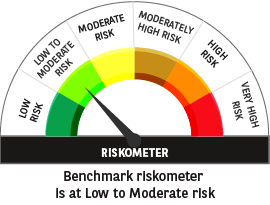AUM
₹ 26.84 Crores
Benchmark
CRISIL Banking and PSU Debt A-II Index
Inception Date
17-12-2020
Expense Ratio (Base)
0.75%
As on 15-09-2025
Corporate Bond
Government Securities/State Development Loans
Cash & Cash Equivalent
A1+/AAA/Sovereign: 87.60
Cash & Cash equivalents: 12.40
Bars show Return distribution (% of times) in a given range for a selected time period.

1 year |
3 years |
5 years |
Since inception |
|
|---|---|---|---|---|
| Regular Plan (% CAGR*) | 7.90% | 6.99% | N.A. | 5.27% |
| Direct Plan (% CAGR*) | 8.34% | 7.55% | N.A. | 5.78% |
| CRISIL Banking and PSU Debt A-II Index (% CAGR*) | 7.70% | 7.24% | N.A. | 5.72% |
| Additional Benchmark CRISIL 10 Year Gilt Index (% CAGR*) | 7.77% | 7.82% | N.A. | 5.22% |
| Value of ₹10,000 Invested In | 1 year |
3 years |
5 years |
Since inception |
|---|---|---|---|---|
| Regular Plan | 10788.18 | 12245.52 | N.A | 12732.00 |
| Direct Plan | 10831.97 | 12437.58 | N.A | 13023.60 |
| CRISIL Banking and PSU Debt A-II Index | 10767.73 | 12329.69 | N.A | 12988.75 |
| Additional Benchmark CRISIL 10 Year Gilt Index | 10774.49 | 12531.14 | N.A | 12704.15 |
Past performance may or may not be sustained in future and is not a guarantee of any future returns. Returns do not take into account the load, if any. Returns are for growth option. Different plans shall have a different expense structure. The performance details provided above are for regular/distributor plan.
Please refer below for fund manager details and performance of other funds managed by the Fund Manager(s)
*Compound annual growth rate
**Benchmark & ***Additional Benchmark
Data As on 31st August 2025 or specified otherwise.

This calculator is provided for informational purposes only.
The results are based on user inputs and should not be considered as investment advice. Users should seek the advice of a qualified financial professional before making any investment decisions.
The creators of the calculator and its affiliates shall not be held responsible for any financial losses resulting from the use of the calculator.
Past performance may or may not be sustained in the future and should not be used as a basis for comparison with other investments. Mutual Fund Investments are subject to market risks, read all scheme related documents carefully.
SIP is allowed in select open ended schemes. Refer the Scheme SAI, SID, KIM for detailed information


Fund BARODA BNP PARIBAS ELSS Tax Saver Fund - Regular - Growth Option
Frequency Monthly
SIP Start Date 05-01-2006
SIP End Date 01-01-2025
Invested Amount ₹22,80,000.00
Current Value ₹1,03,86,141.98
Scheme Returns 14.17%
Benchmark Returns 14.12%
TER (Total Expense Ratio) 2.2%
This calculator is provided for informational purposes only.
The results are based on user inputs and should not be considered as investment advice. Users should seek the advice of a qualified financial professional before making any investment decisions.
The creators of the calculator and its affiliates shall not be held responsible for any financial losses resulting from the use of the calculator.
Past performance may or may not be sustained in the future and should not be used as a basis for comparison with other investments. Mutual Fund Investments are subject to market risks, read all scheme related documents carefully.
SIP is allowed in select open ended schemes. Refer the Scheme SAI, SID, KIM for detailed information
The scheme seeks to provide regular income through a portfolio of debt and money market instruments consisting predominantly of securities issued by entities such as Banks, Public Sector Undertakings (PSUs), Public Financial Institutions and Municipal Bonds. However, there can be no assurance that the investment objectives of the Scheme will be realized. The Scheme does not guarantee/indicate any returns.
Entry Load : Not Applicable.
Exit Load: No exit load will be charged for Income Distribution cum capital withdrawal option reinvestment units. Transaction charges, if applicable, shall be deducted. The above mentioned load structure is also applicable to SIP investments.
Lumpsum Details:
Minimum Application Amount: ₹ 5,000 and in multiples of ₹ 1 thereafter.
Minimum Additional Application Amount: ₹ 1,000 and in multiple of ₹ 1 thereafter
(i) Daily, Weekly, Monthly SIP: ₹ 500/- and in multiples of ₹ 1/- thereafter;
(ii) Quarterly SIP: ₹ 1500/- and in multiples of ₹ 1/- thereafter. There is no upper limit
₹ 1000/Installment - 6 Installments - Frequency - Daily/Weekly/Fortnightly/Monthly/
₹ 1500/Installment - 4 Installments - Frequency - Quarterly
Withdrawal must be for a minimum amount of ₹ 1,000/- or in multiples of Re.1/- thereafter, in Weekly / Monthly SWP and ₹ 1,500/- and in multiples of Re.1/- thereafter, in Quarterly SWP.
An open ended debt scheme predominantly investing in debt instruments of banks, Public Sector Undertakings, Public Financial Institutions and Municipal Bonds. A Relatively High Interest Rate Risk and Moderate Credit Risk.
This product is suitable for investors who are seeking*:
- Generate returns over short to medium term.
- Invest primarily in debt instruments of Banks, PFIs, PSUs and Municipal Bonds.


^^Riskometer For Scheme: basis it's portfolio, ^Riskometer For Benchmark (CRISIL Banking and PSU Debt A-II Index): basis it's constituents; as on August 31, 2025
*Investors should consult their financial advisers if in doubt about whether the product is suitable for them.

Gurvinder Singh Wasan
CFA, Fund Manager
Managing this fund since October 2024
Performance of Other Funds Managed by Gurvinder Singh Wasan
Vikram Pamnani
Fund Manager - Fixed Income
Managing this fund since July 2024
Performance of Other Funds Managed by Vikram Pamnani
An open ended debt scheme predominantly investing in debt instruments of banks, Public Sector Undertakings, Public Financial Institutions and Municipal Bonds. A Relatively High Interest Rate Risk and Moderate Credit Risk.
Debt
₹ 12.7688
NAV as on 15-09-2025

5.27 %
Returns lumpsum
| Schemes (Benchmark Index) | 1 Year CAGR | 3 Year CAGR | 5 Year CAGR | |||
|---|---|---|---|---|---|---|
| Scheme Returns | Benchmark Returns | Scheme Returns | Benchmark Returns | Scheme Returns | Benchmark Returns | |
| Baroda BNP Paribas Aggressive Hybrid Fund (CRISIL Hybrid 35+65 - Aggressive Index) | -2.66% | -0.24% | 13.57% | 11.70% | 16.05% | 14.94% |
| Baroda BNP Paribas Balanced Advantage Fund (NIFTY 50 Hybrid Composite Debt 50:50 Index) | 0.83% | 2.53% | 13.04% | 10.06% | 13.98% | 12.12% |
| Baroda BNP Paribas Banking and PSU Bond Fund (CRISIL Banking and PSU Debt A-II Index) | 7.90% | 7.70% | 6.99% | 7.24% | N.A.* | N.A.* |
| Baroda BNP Paribas Conservative Hybrid Fund (CRISIL Hybrid 85+15 - Conservative Index) | 3.59% | 5.38% | 7.93% | 8.50% | 7.50% | 8.09% |
| Baroda BNP Paribas Corporate Bond Fund (CRISIL Corporate Debt A-II Index) | 10.09% | 8.82% | 7.10% | 7.03% | 6.20% | 6.62% |
| Baroda BNP Paribas Credit Risk Fund (CRISIL Credit Risk Debt B-II Index) | 8.52% | 8.77% | 7.75% | 8.22% | 9.84% | 7.40% |
| Baroda BNP Paribas Dynamic Bond Fund (CRISIL Dynamic Bond Debt A-III Index) | 5.04% | 6.83% | 6.62% | 7.32% | 5.31% | 5.93% |
| Baroda BNP Paribas Equity Savings Fund (NIFTY Equity Savings Index TRI) | 3.46% | 4.53% | 9.27% | 9.43% | 8.26% | 10.41% |
| Baroda BNP Paribas GILT Fund (CRISIL Dynamic Gilt Index) | 6.28% | 6.53% | 7.34% | 7.71% | 5.40% | 6.07% |
| Baroda BNP Paribas GOLD ETF (Domestic Price of Gold) | 40.49% | 42.39% | N.A.* | N.A.* | N.A.* | N.A.* |
| Baroda BNP Paribas Liquid Fund (CRISIL Liquid Debt A-I Index) | 6.84% | 6.80% | 6.95% | 6.98% | 5.60% | 5.67% |
| Baroda BNP Paribas Low Duration Fund (CRISIL Low Duration Debt A-I Index) | 7.31% | 7.76% | 6.81% | 7.39% | 5.51% | 6.05% |
| Baroda BNP Paribas Money Market Fund (CRISIL Money Market A-I Index) | 7.76% | 7.23% | 7.12% | 7.25% | 5.51% | 5.91% |
| Baroda BNP Paribas NIFTY SDL December 2026 INDEX Fund (NIFTY SDL December 2026 Index) | 7.77% | 8.27% | N.A.* | N.A.* | N.A.* | N.A.* |
| Baroda BNP Paribas NIFTY SDL December 2028 INDEX Fund (NIFTY SDL DECEMBER 2028 INDEX) | 7.75% | 8.25% | N.A.* | N.A.* | N.A.* | N.A.* |
| Baroda BNP Paribas Overnight Fund (CRISIL Liquid Overnight Index) | 6.13% | 6.22% | 6.39% | 6.50% | 5.19% | 5.31% |
| Baroda BNP Paribas Retirement Fund (CRISIL Hybrid 35+65 - Aggressive Index) | -0.35% | -0.24% | N.A.* | 11.70% | N.A.* | 14.94% |
| Baroda BNP Paribas Short Duration Fund (CRISIL Short Duration Debt A-II Index) | 8.09% | 8.27% | 7.31% | 7.48% | 5.85% | 6.11% |
| Baroda BNP Paribas Ultra Short Duration Fund (CRISIL Ultra Short Duration Debt A-I Index) | 7.48% | 7.35% | 7.27% | 7.35% | 5.90% | 6.01% |
Period for which scheme's performance has been provided is computed basis last day of the month-end preceding the date of advertisement.
Past performance may or may not be sustained in future and should not be used as a basis of comparison with other investments. Returns do not take into account the load, if any. Returns are for growth option. Different plans shall have a different expense structure. The performance details provided above are for regular/distributor plan.
For Fund Manager(s) & Managing Since Details click here
*Where returns are not available for that particular period, they have not been shown.
| Schemes (Benchmark Index) | 1 Year CAGR | 3 Year CAGR | 5 Year CAGR | |||
|---|---|---|---|---|---|---|
| Scheme Returns | Benchmark Returns | Scheme Returns | Benchmark Returns | Scheme Returns | Benchmark Returns | |
| Baroda BNP Paribas Arbitrage Fund (Nifty 50 Arbitrage Index) | 6.34% | 7.65% | 6.88% | 7.44% | 5.51% | 5.96% |
| Baroda BNP Paribas Banking and PSU Bond Fund (CRISIL Banking and PSU Debt A-II Index) | 7.90% | 7.70% | 6.99% | 7.24% | N.A.* | N.A.* |
| Baroda BNP Paribas Corporate Bond Fund (CRISIL Corporate Debt A-II Index) | 10.09% | 8.82% | 7.10% | 7.03% | 6.20% | 6.62% |
| Baroda BNP Paribas Credit Risk Fund (CRISIL Credit Risk Debt B-II Index) | 8.52% | 8.77% | 7.75% | 8.22% | 9.84% | 7.40% |
| Baroda BNP Paribas Liquid Fund (CRISIL Liquid Debt A-I Index) | 6.84% | 6.80% | 6.95% | 6.98% | 5.60% | 5.67% |
| Baroda BNP Paribas Low Duration Fund (CRISIL Low Duration Debt A-I Index) | 7.31% | 7.76% | 6.81% | 7.39% | 5.51% | 6.05% |
| Baroda BNP Paribas Money Market Fund (CRISIL Money Market A-I Index) | 7.76% | 7.23% | 7.12% | 7.25% | 5.51% | 5.91% |
| Baroda BNP Paribas Multi Asset Fund (65% of Nifty 500 TRI + 20% of NIFTY Composite Debt Index + 15% of INR Price of Gold ) | 1.95% | 4.15% | N.A.* | N.A.* | N.A.* | N.A.* |
| Baroda BNP Paribas NIFTY SDL December 2026 INDEX Fund (NIFTY SDL December 2026 Index) | 7.77% | 8.27% | N.A.* | N.A.* | N.A.* | N.A.* |
| Baroda BNP Paribas NIFTY SDL December 2028 INDEX Fund (NIFTY SDL DECEMBER 2028 INDEX) | 7.75% | 8.25% | N.A.* | N.A.* | N.A.* | N.A.* |
| Baroda BNP Paribas Overnight Fund (CRISIL Liquid Overnight Index) | 6.13% | 6.22% | 6.39% | 6.50% | 5.19% | 5.31% |
| Baroda BNP Paribas Short Duration Fund (CRISIL Short Duration Debt A-II Index) | 8.09% | 8.27% | 7.31% | 7.48% | 5.85% | 6.11% |
| Baroda BNP Paribas Ultra Short Duration Fund (CRISIL Ultra Short Duration Debt A-I Index) | 7.48% | 7.35% | 7.27% | 7.35% | 5.90% | 6.01% |
Period for which scheme's performance has been provided is computed basis last day of the month-end preceding the date of advertisement.
Past performance may or may not be sustained in future and should not be used as a basis of comparison with other investments. Returns do not take into account the load, if any. Returns are for growth option. Different plans shall have a different expense structure. The performance details provided above are for regular/distributor plan.
For Fund Manager(s) & Managing Since Details click here
*Where returns are not available for that particular period, they have not been shown.